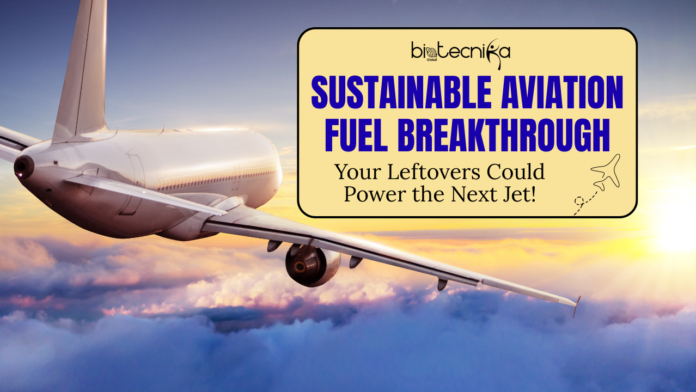Sustainable Aviation Fuel Breakthrough: Your Leftovers Could Power the Next Jet!
What if the apple core you tossed this morning could one day power your next flight? That’s no longer science fiction. It’s science in action. A group of researchers at the University of Illinois Urbana-Champaign has discovered a breakthrough method that turns everyday food waste into Sustainable Aviation Fuel (SAF) capable of powering aircraft without a single drop of fossil fuel.
This isn’t just a laboratory curiosity. Published in Nature Communications, the study represents a milestone for life sciences, biotechnology, and bioengineering for clean energy, opening the door to a future where carbon-neutral aviation fuel is made from yesterday’s leftovers.
A Green Biotechnology Breakthrough for Air Travel
Airplanes have made our world smaller, but their carbon footprint looms large. The aviation industry contributes nearly 2.5% of global greenhouse gas emissions, and as passenger numbers grow, the need for renewable fuels from biomass becomes urgent.
Now, thanks to this innovation in green biotechnology, scientists are finding value in what we throw away. The Illinois research team used discarded food from a nearby processing plant and transformed it into bio-based jet fuel that meets, and even exceeds, international aviation standards.
The key to this transformation? Hydrothermal liquefaction technology is a process that mimics nature’s way of forming crude oil, but compresses millions of years of chemistry into just a few hours.
How Life Sciences Are Powering a Fuel Revolution
Led by Professor Yuanhui Zhang, a specialist in Agricultural and Biological Engineering, the researchers used bioprocess engineering innovation to turn food waste into “biocrude.” The material is then refined using hydrogen and catalysts, stripping away unwanted elements like oxygen, nitrogen, and sulfur.
The result is a biofuel production process that yields high-quality Sustainable Aviation Fuel, one that passed Tier Alpha and Beta screening by ASTM and the FAA, confirming it can power modern aircraft without blending with fossil fuel.
“Our work solves both the scientific and engineering challenges,” said Zhang. “It’s not just about creating fuel. It’s about reimagining waste as a resource and advancing the circular bioeconomy in life sciences.”
From Food Waste to Jet Fuel: The Bigger Picture
Do you know that globally, 30% of food produced is wasted? They are left to rot in landfills or water systems. They are releasing harmful chemicals like methane and carbon dioxide into the environment. By converting this waste into eco-friendly jet fuel, researchers are not only tackling emissions from aviation but also reducing the impact of decaying food on climate change.
The technology also extends beyond food waste. According to the Illinois team, the same process can use other organic materials like algae, crop residues, or even animal fats, making it a versatile solution for biological waste conversion and environmental biotechnology.
If scaled commercially, this could be a major leap forward for carbon-neutral aviation and a shining example of biotechnology in renewable energy at work.
Why Sustainable Aviation Fuel Matters for the Future of Flight
This new discovery could change the whole aviation industry’s long-term sustainability goals. In contrast to the earlier sustainable aviation fuels (SAFs), which were mixed with fossil-based jet fuel, this new sustainable aviation fuel is a 100% renewable alternative. It’s all set to be used in existing aircraft. This will help the aviation industry in achieving net-zero carbon emissions by 2050.
But the impact goes beyond aviation. The same technology could potentially replace petroleum-derived compounds now used in the production of plastics and other industrial materials. That means its value stretches across multiple sectors, from transportation to manufacturing, linking cleaner skies with a broader shift toward a bio-based economy.
For the life sciences community, the finding underscores how research in bioengineering and bioprocess technology can influence global sustainability efforts. It’s proof that innovations born in university labs can redefine how industries use resources and manage waste.
Challenges and the Road Ahead
Still, the journey from lab to runway won’t be simple. So far, the process has been proven only on a laboratory scale. A stable source of feedstock, efficient waste-collecting systems, and significant investment in refining infrastructure are required for upscaling.
Despite these hurdles, the timing could not be better. As the world accelerates the shift toward clean energy solutions, this breakthrough stands out as a beacon in the fast-growing field of waste-to-energy research.
It’s important to highlight how life science innovation can translate into real environmental progress, turning food waste into fuel, economic potential, and hope for a more sustainable future.
A Future Fueled by Science, and Scraps
In a world desperate for climate-smart technologies, the University of Illinois breakthrough shows that sustainability might just start with what’s on our plates. If this process reaches commercial scale, the next time you fly, your airplane could literally be running on last night’s leftovers, a fitting symbol of how far biotechnology for clean energy has come.






